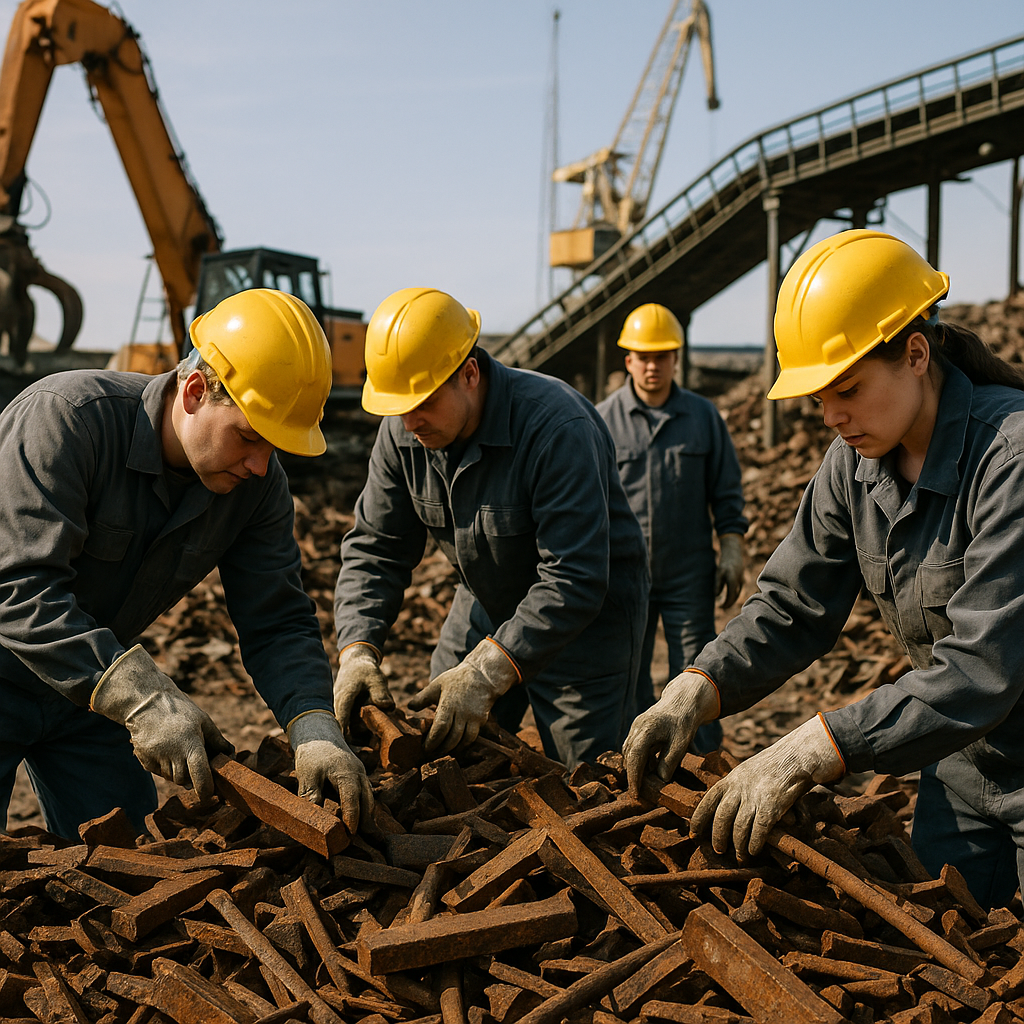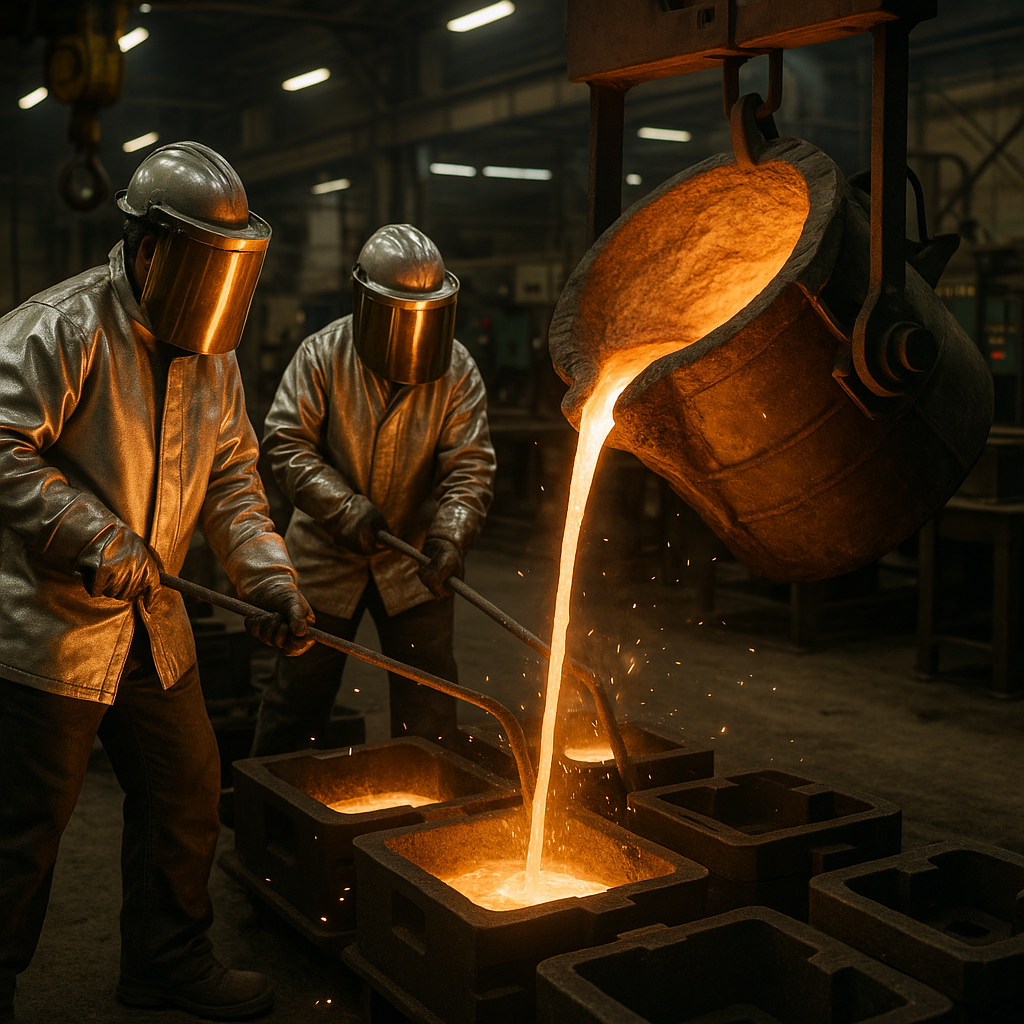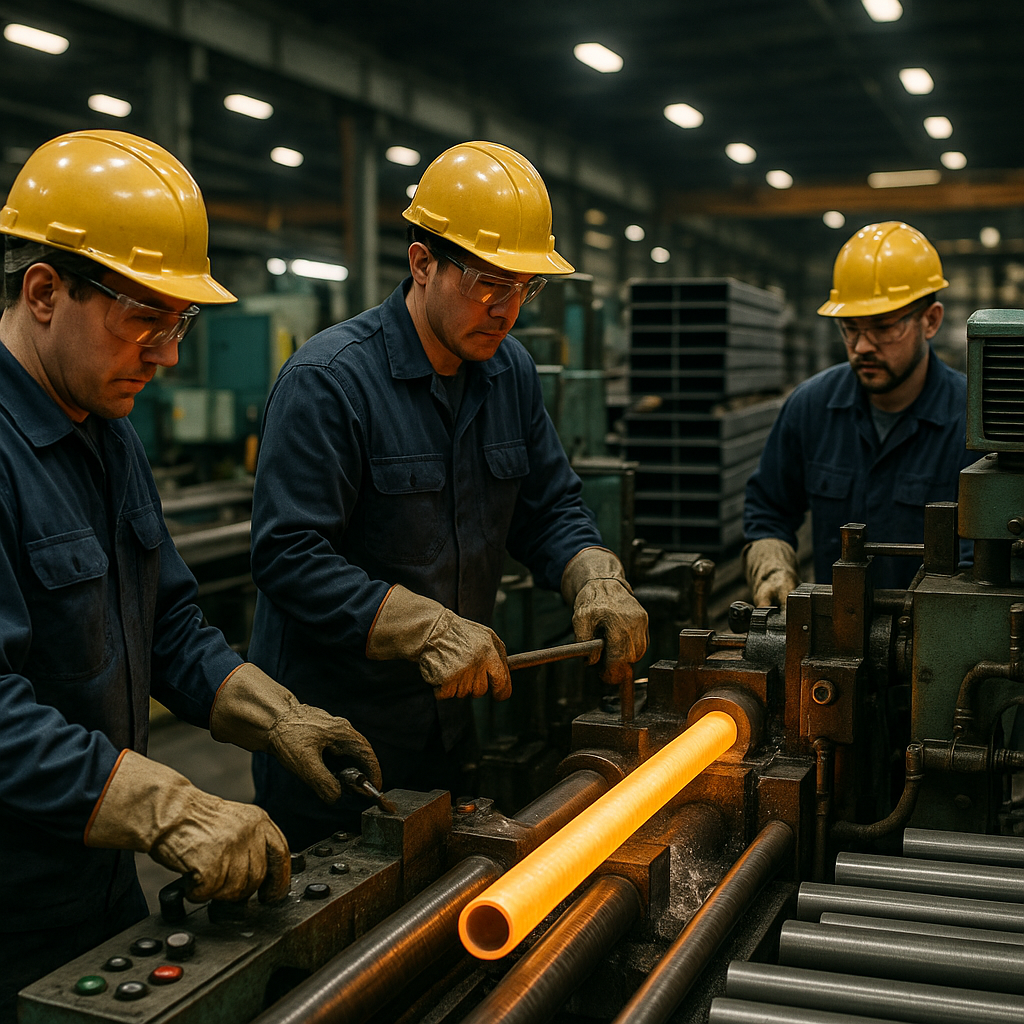5901 Botham Jean Blvd, Dallas, TX 75215
Melting Iron Scrap: Process, Preparation, and Benefits of Recycling
October 4, 2025Melting iron scrap is central to modern metal recycling. This process transforms discarded iron and steel into valuable resources. Using specialized furnaces, scrap iron is heated to over 1,370°C (2,500°F), converting solid metal waste into a molten form ready for reuse.
The journey begins with collection and sorting. Recyclers categorize iron scrap into heavy melting steel (HMS) grades based on thickness, quality, and composition. HMS 1 includes pure wrought iron or steel at least 1/4 inch thick without galvanized or blackened steel. HMS 2 consists of thinner pieces with galvanized components, starting at 1/8 inch thickness.
This transformation process supports sustainable manufacturing while providing substantial environmental benefits. By recycling one ton of steel, we conserve 2,500 pounds of iron ore, 1,400 pounds of coal, and 120 pounds of limestone. The energy savings are equally impressive, with steel recycling reducing energy consumption by 60% compared to mining and processing virgin materials.
How is Iron Scrap Prepared for Melting?

Before iron scrap can be transformed into recycled metal through the melting process, it must undergo several crucial preparation steps. Proper preparation ensures a more efficient melting operation and significantly impacts the quality of the final recycled metal product.
Collection and Sorting
The preparation process starts with collecting iron scrap from various sources, including manufacturing facilities, construction sites, and end-of-life products. Once collected, the scrap undergoes thorough sorting processes to separate materials by type and quality.
Modern recycling facilities use various sorting techniques to ensure high-quality feedstock, including magnetic separation to efficiently distinguish ferrous materials like iron from non-ferrous metals. Some advanced facilities also use AI vision systems to analyze and rate scrap quality, maintaining consistent standards throughout the sorting process.
Proper sorting is crucial because contaminants or mixed metals can compromise the melting process and affect the final product’s quality. Higher density iron scrap typically receives better ratings, as it allows more efficient melting and yields higher returns.
Size Reduction Through Shredding and Cutting
After sorting, iron scrap is processed through shredding or cutting to reduce its size. This step is essential for several reasons. Smaller pieces are easier to transport and handle, and importantly, size reduction significantly increases the surface area to volume ratio of the scrap.
This increased surface area allows heat to penetrate the metal more efficiently during melting. Depending on the scrap’s original size and composition, hydraulic equipment, industrial shredders, and torches are commonly used tools for this process.
The resulting smaller pieces make the subsequent melting phase more efficient by:
- Reducing the energy required for complete melting
- Shortening the melting time
- Improving furnace loading capacity
- Creating more uniform heating throughout the batch
Density Optimization
Maintaining high-density charges is another critical aspect of scrap preparation. Dense, well-packed scrap loads maximize furnace efficiency by increasing the amount of metal that can be melted in a single batch. Some facilities use compactors to compress scrap into denser forms before melting.
Continuous charging systems may also be employed during the melting process to maintain optimal density levels. These systems allow for the addition of prepared scrap throughout the melting cycle, keeping the furnace at full capacity for maximum energy efficiency.
Contaminant Removal
Before the final melting stage, any remaining contaminants must be removed from the scrap, including non-metallic materials like plastic, rubber, or other debris that could interfere with the process or introduce impurities into the recycled metal.
Some facilities use specialized equipment like the DE-STONER® to remove unwanted lightweight materials based on density differences. This final cleaning step ensures that only high-quality iron scrap enters the furnace, resulting in better quality recycled metal with fewer defects.
The careful preparation of iron scrap through collection, sorting, size reduction, and contaminant removal lays the foundation for efficient melting operations. These preparatory steps not only reduce energy consumption but also maximize yield and ensure the production of high-quality recycled metal.
What Happens During the Iron Scrap Melting Process?

The melting process transforms solid iron scrap into liquid metal through a carefully controlled sequence of operations in specialized furnaces. These industrial furnaces reach extreme temperatures exceeding 1,200°C, breaking the metallic bonds that hold the iron atoms in their rigid crystalline structure.
As the scrap heats up, a fascinating physical transformation occurs. The outer layers of the metal first begin to soften and glow red-hot, and as temperatures climb further, the entire mass becomes molten. This process requires tremendous thermal energy, with different furnace types delivering heat through various methods. Induction furnaces use electromagnetic fields to generate heat directly within the metal, while electric arc furnaces create intense heat through electric arcs between electrodes and the scrap.
During melting, the furnace environment plays a crucial role in impurity management. Contaminants in the scrap, such as sand, plastic, wood fragments, or surface coatings, don’t simply disappear. Organic materials typically burn off as the temperature rises, while non-combustible impurities like sand and other minerals form slag that floats to the surface of the molten metal, where it can be skimmed off.
The efficiency of the melting process varies considerably based on several key factors. Furnace size determines overall capacity, while heat levels affect melting speed. The composition and density of the scrap load significantly impact melt times, with heavily oxidized or contaminated scrap requiring more energy and processing time. A typical melt cycle might take anywhere from 30 minutes to several hours, depending on these variables.
One compelling advantage of recycling iron scrap is its energy efficiency compared to primary production. Melting recycled iron consumes approximately 40-50% less energy than extracting new metal from iron ore. This reduction occurs because recycling bypasses the energy-intensive processes of mining, ore concentration, and the reduction of iron oxide to metallic iron. For every ton of recycled iron, between 1.5-2 tons of iron ore and 0.5 tons of coal remain untouched, preserving valuable natural resources.
Modern melting operations continue to enhance efficiency through practices like preheating scrap with exhaust gases, optimizing furnace insulation, and implementing precise temperature controls. These innovations further reduce the already significant energy advantage that recycled iron enjoys over virgin material production.
How is Melted Iron Scrap Transformed into New Products?

Once melted and purified, liquid iron scrap begins its journey toward becoming valuable new products. The molten metal flows from furnaces into specialized molds to form ingots, billets, or bars. These standardized shapes cool and solidify under carefully controlled conditions to prevent internal stresses and ensure consistent quality throughout the metal.
The solidified forms serve as the foundation for further manufacturing processes. Manufacturers often send these ingots through hot rolling mills, where the metal is heated and pressed between heavy rollers. This process shapes the metal into sheets, plates, or structural forms depending on their intended applications. Some products require additional processes like cutting, stamping, or machining to achieve their final specifications.
The versatility of recycled iron and steel is remarkable. Construction companies transform these materials into beams, rebar, and structural components for buildings and infrastructure. Manufacturers use recycled metal to produce automotive parts, appliances, tools, and numerous consumer goods. The applications span virtually every industry that requires durable metal components.
One of the most significant advantages of iron and steel recycling is that these metals maintain their inherent properties regardless of how many times they undergo the recycling process. Unlike some materials that degrade with repeated recycling, steel and iron can be reprocessed indefinitely without quality loss. This infinite recyclability makes iron-based metals ideal for a sustainable, circular economy where resources remain in productive use rather than becoming waste.
The transformation process conserves substantial resources compared to virgin metal production. Recycling steel saves approximately 2,500 pounds of iron ore, 1,400 pounds of coal, and 120 pounds of limestone for every ton processed. This represents significant energy savings, with steel recycling consuming up to 74% less energy than producing new steel from raw materials.
Modern Innovations in Recycled Metal Manufacturing
Recent technological advances have further enhanced the efficiency of transforming melted iron scrap into new products. Computer-controlled continuous casting equipment allows for more precise formation of standardized shapes with minimal waste. These systems monitor and adjust temperatures and cooling rates to optimize the metal’s microstructure and resulting properties.
Advanced mills now incorporate automation and precision controls, enabling recycled metal to meet increasingly stringent quality specifications. This has expanded the potential applications for recycled metals into sectors that once relied exclusively on virgin materials. Today, even highly demanding industries like aerospace and medical device manufacturing can utilize recycled metals for certain components.
Quality control remains paramount throughout the transformation process. Manufacturers regularly test samples to verify chemical composition, tensile strength, and other critical properties. These tests ensure the recycled metal meets or exceeds the performance requirements for its intended applications.
Product Applications for Recycled Iron and Steel
The range of products manufactured from recycled iron and steel continues to expand. Construction materials represent one of the largest markets, with recycled metal going into everything from structural beams to reinforcing bars. The automotive industry incorporates recycled steel into vehicle bodies, chassis components, and engine parts.
Consumer goods production represents another significant application. Kitchen appliances, furniture frames, tools, and countless household items contain recycled metal. Even food and beverage containers often include recycled steel, particularly in their base materials.
Infrastructure development relies heavily on recycled metals. Bridges, highways, railways, and utility systems all incorporate substantial amounts of recycled steel. These applications highlight both the durability and versatility of properly processed recycled metal.
The circular nature of metal recycling creates a sustainable materials loop. Products manufactured today will eventually become the raw materials for future generations of metal goods. This cyclical approach reduces dependence on mining, conserves natural resources, and minimizes the environmental impact associated with metal production while meeting the world’s continuing demand for metal products.
Conclusion: The Impact and Future of Melting Iron Scrap

Melting iron scrap plays a vital role in sustainable metal production as environmental awareness grows. This process offers significant environmental benefits by reducing CO2 emissions by up to 58% compared to producing virgin materials. Recycling one ton of steel conserves about 1.5 tons of iron ore, 0.65 tons of coal, and 0.3 tons of limestone, essential as demand on Earth’s limited resources increases.
The economic benefits are also noteworthy. The recycling industry generates billions in economic activity and creates diverse employment opportunities across collection, processing, and manufacturing sectors. Manufacturers using recycled metals often save up to 33% compared to those using new materials. These savings boost the entire supply chain, from competitive pricing for producers to reduced costs for consumers.
For your ferrous scrap recycling needs, contact Okon Recycling at 214-717-4083. Our team can help you maximize the value of your scrap metal while ensuring responsible processing that supports a more sustainable future for the metal industry.
